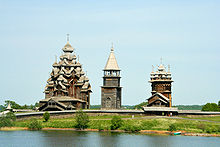
The Blue Highway (Norwegian: Blå vegen, Swedish: Blå vägen, Finnish: Sininen tie, Russian: Голубая дорога) is a route in Northern Europe, stretching from Mo i Rana on the Atlantic coast through Norway, Sweden and Finland to Pudozh in Russia, across Lake Onega from Petrozavodsk. It follows ancient waterways from the Atlantic Ocean to Lake Onega, hence the name "Blue Highway".
Understand

The route is about 1,800 km long and probably best experienced by car. Much of the route is through sparsely populated countryside or wilderness, with great opportunities for outdoor life.
Through Norway (from Mo i Rana) and Sweden it is known as European Route E12, except a short stretch in Umeå. The route through Finland follows the highways 18, 16, 13 (just a short stretch), 77, 5 and 9. Finally, the route through Russia follows the highways 86-K8, A-121, P-21 and A-119.
Prepare
Check which visas and car documents you need (e.g. carnet de passage). Citizens of most countries need a visa to Russia, and citizens of most non-western countries need one for the Schengen area, which includes Norway, Sweden and Finland.
Get in

Mo i Rana is at the highway E6 coming in from Oslo and the Swedish west coast and continuing through the country to the Russian border in the far north-east. Nesna is a port on the Hurtigruten ship line (most ferries on the line take cars), beginning in Bergen and likewise going up all the way to Kirkenes.
In the other end, Petrozavodsk is a little over 400 km by road from St. Petersburg and 1050 km from Moscow. Pudozh, on the eastern side of Lake Onega is a bit further away from St. Petersburg and correspondingly closer to Moscow.
Drive

- 1 Mo i Rana, by Ranelva, Ranfjord, Saltfjället and the Svartisen glacier. Famous for the numerous caves, two of which are developed as attractions.
In Sweden the route follows the Ume river, from some distance after Hemavan.
- 2 Hemavan, a ski resort by Sweden's largest nature reserve, and with a botanic garden.
- 3 Storuman; junction with E45
- 4 Lycksele, with a forestry museum and a zoo.
- 5 Umeå, regional capital of Västerbotten, a university town with some 110.000 inhabitants. Junction with E4.
The ropax ferry between the river mouth by Holmsund, Umeå, and Vaasa, tries its best to attract cruise passengers as well, although not as glamorous as the ferries from Stockholm. The route goes over Kvarken, the shallow sea area between the Bothnian Sea and the Bothnian Bay. The Kvarken Archipelago off Vaasa is a ![]() UNESCO World Heritage Site together with Höga kusten on the Swedish side.
UNESCO World Heritage Site together with Höga kusten on the Swedish side.
- 6 Vaasa, regional capital of Swedish-speaking Ostrobothnia, a university town with some 70.000 inhabitants.
- 7 Alajärvi, sister city of Pudozh. Several buildings by Alvar Aalto, the most famous architect of Finland, who lived here as child. Also museum of artist Eero Nelimarkka.
- 8 Kyyjärvi, 30 km from Salamajärvi National Park.
- 9 Viitasaari, with the rapids Huopanankoski, a famous fishing site, part of the Kymijoki system.
The route continues through the Finnish Lakeland.
- 10 Vesanto, a village with musical traditions and a wooden church from 1857.
- 11 Kuopio, regional capital of North Savonia, with some 120.000 inhabitants.
- 12 Joensuu, regional capital of North Karelia, with some 80.000 inhabitants
The road crosses borders at Niirala/Värtsilä in Tohmajärvi/Vyartsilya.
- 13 Petrozavodsk, capital of Russian Karelia, with some 260.000 inhabitants, by Lake Onega.
- 14 Pudozh, on the other side of Onega, with some 10.000 inhabitants.
Stay safe
Traffic is light to moderate along this itinerary, and traffic jams and the like aren't an issue at all. Wildlife accidents, on the other hand, are certainly common.
If you make the trip between November and April, there's a good chance for snow and ice on the roads. During that time of the year, the environment looks a lot different than during the summer.
Go next
If you've ended your trip at the eastern end of the itinerary, you can for instance head southwest to Saint Petersburg, southeast to Moscow and the cities along the Golden Ring or north to Murmansk or Arkhangelsk.
If you have ended your trip at the western end, you can take the E6 highway or Hurtigruten ferry north or south through Norway, or head back to Sweden.

